6 Important Social Media Metrics to Track in 2022 [+Bonus Tip]
Nowadays, almost every business runs Facebook, Instagram, or LinkedIn pages. Some B2C companies (e.g., Guess, HP) find TikTok a great tool to engage users. Everyone who had a chance to run social media channels knows that it isn’t easy.

Algorithms change very often, organic reach lowers, and ads prices can surprise. But no matter what happens, SM managers need to track metrics.
First, let me ask you a few questions:
- What is the value of social media marketing?
- How do you assess your own performance?
- How to effectively measure social traffic and revenue generated by social channels?
I hope you know the answers. If not, don’t worry; I will show you how to measure the results of your social media efforts.
You may show the number of followers, tweets, engagement rate, and post reaches to your managers, but the question is, did all these really had any impact on the bottom line?
The answer is a loud ‘No’, and that is where our concerns start. You need to be able to measure the performance of your social channels.
That’s where key social media metrics come to the rescue! Let’s see what’s ahead of us:
What are social media metrics?
Social media metrics are the statistics and other data you can pull from your social accounts that are indicators of your marketing performance.
Some metrics are universal and can be applied to all social platforms, while others are channel-specific.
In this post, I’ll focus on universal social media marketing metrics. Even when applying the universal social media metrics will give you a general idea of how your social channels are performing. And once you have analytics in place, you will know what to do to improve your conversions.
I would also like to focus on more substantial metrics. What kind of?
Metrics that will help you build a robust presence, boost your brand awareness, or develop successful campaigns.
That’s why you won’t find vanity metrics in this post. A growing followers’ count looks nice on a paper but isn’t, especially in the time of bots, an indicator of a healthy social media presence.
But before we start, you might wonder why bother with measuring the ROI of a Facebook post at all? Measuring the conversion rate from social media is crucial for your success.
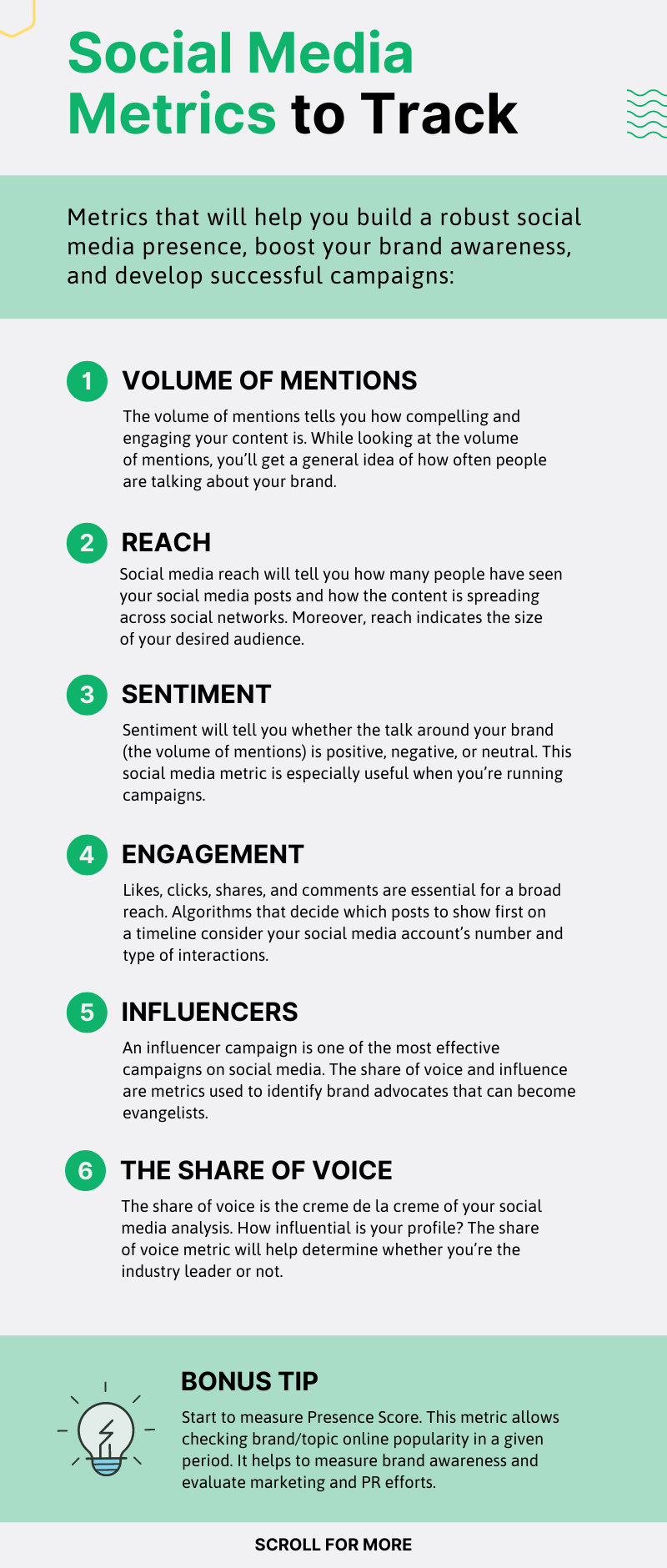
What metrics to measure in social media?
So, what are the mystery SM metrics that will give you insights into your social media marketing strategy and set you ahead of your competitors?
Each social platform has statistics that show data related to:
- Followers
- Clicks
- Traffic
- Engagement
- Conversions
But can you track more? Of course, but you’ll need some tools to do that.
In this article, I’m basing my social media analysis on results delivered by the monitoring tool – Brand24.
Brand24 gathers all the brand mentions containing your predefined keyword and analyses the results.
You can use the metrics provided by Brand24 to understand your social appearance better.
Let’s take a look!
What metrics should you focus on? It all depends on your social media KPI’s.
As you know, you can use social channels to achieve different results. You can implement a strategy that will:
- Increase your brand awareness
- Increase the number of your brand mentions
- Improve your customer service levels
- Boost your conversions
- Help you reach your target audience
- Expand your social share of voice
All of these social media goals require a slightly different set of metrics. The good news is, you can find metrics you can easily track.
So, you will know what you are doing well. And even more importantly, what aspects of your social media strategy do you need to improve.
Track social media mentions with Brand24. The 14-day trial is free of charge and no card is required.
Key social media metrics you should track:
1. Volume of mentions
The volume of mentions tells you how compelling and engaging your content is. While looking at the volume of mentions, you’ll get a general idea of how often people are talking about your brand.
Measuring the volume of mentions from social channels over time helps spot any seasonal changes in interest. Maybe there’s a time of year when you could reach potential customers more easily and deliver better results?
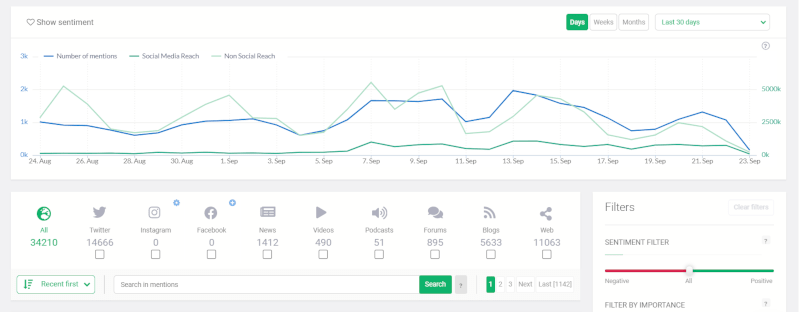
It might happen that the interest in your product will spike through the year.
For example, in the SaaS industry, we can expect a spike in interest around Black Friday in November and in late October.
Potential customers probably conduct research around the tools they would like to buy during Black Friday madness. Based on the volume of mentions metric, we should invest a bit more in promotion a month before Black Friday.
2. Reach
Reach is a metric you should follow closely, especially if you’re running a social media campaigns.
Social media reach will tell you how many people have seen posts on your social channels and how the content is spreading across social networks.
Moreover, reach indicates the size of your desired audience. You can assume that followers are interested in your message and, possibly, product.

The higher reach, the bigger audience could have seen your product. From a technical point of view, measuring this parameter is a piece of cake.
All you have to do is come up with a dedicated hashtag and set up a social media monitoring project with the hashtag as a keyword. And that’s it!
The volume of mentions and reach are metrics associated with brand awareness.
Brand awareness will help you establish your company as a business leader within your niche. Increasing awareness levels creates a level of trust between your customers and your brand. Furthermore, it helps to reach new audiences.
3. Sentiment
The volume of mentions is the metric on which you’ll base your social media analysis.
Other metrics will give you the context necessary to make the most informed decisions.
First thing on the table – sentiment.
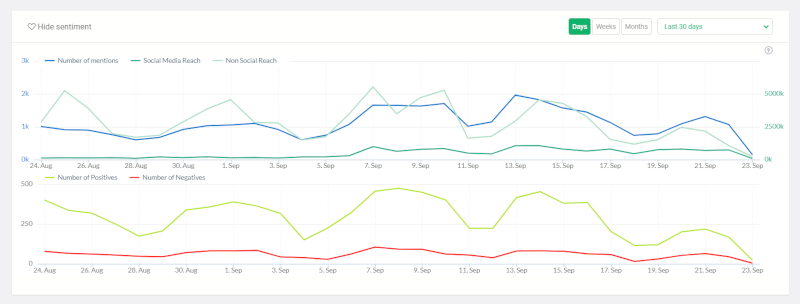
Sentiment will tell you whether the talk around your brand (the volume of mentions) is positive, negative, or neutral. This social media metric is especially useful when you’re running campaigns.
Initially, a high volume of mentions might suggest that the campaign is a success. After all, people are talking about your brand.
But that’s not the whole picture.
A high volume of mentions and prevailing negative sentiment is a call for trouble. It means that social media crisis is on its way, and you have to implement your crisis management plan into action.
With the Brand24 tool, you can easily filter the negative and positive mentions. So you can react to unsatisfied customers in time, preventing the escalation of the crisis.
Check out Chia’s video on measuring the sentiment in social channels:
4. Engagement rate
Your content needs to ignite discussion and tempt users to leave some interaction. That’s where engagement metrics come in handy. And this is one of the crucial social media metrics to track.
Algorithms that decide which content to show first on a timeline consider your social media account’s number and type of interactions. So, likes, clicks, shares, and comments are essential for a broad reach.
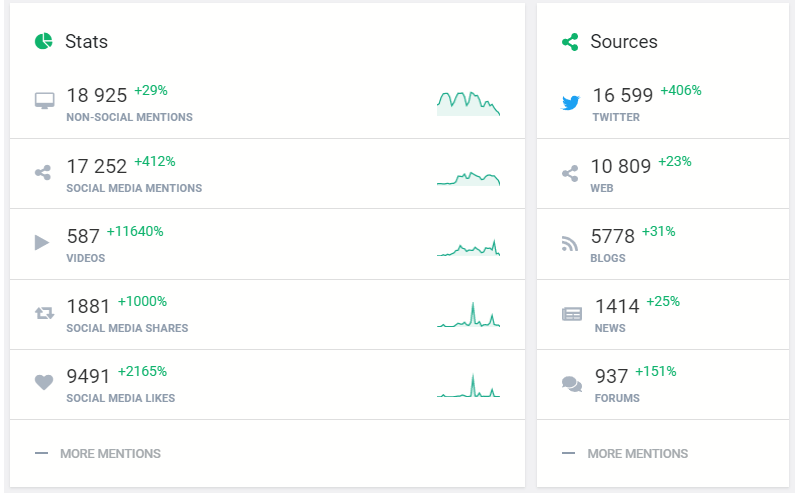
In other words, the more comments, likes, and shares your posts have, the more people will see your content and the bigger exposure you’ll have.
Numbers and type of interactions are, therefore, one of the most powerful social media metrics. The engagement rate will tell you how interesting your posts are.
My observations tell me that organic mentions are also an essential factor that impacts engagement and reach. It’s worth monitor brand mentions and conduct interaction. Your followers will appreciate that. As a result, it will be much easier to build a community. Also, you can improve customer satisfaction by answering to complaining clients.
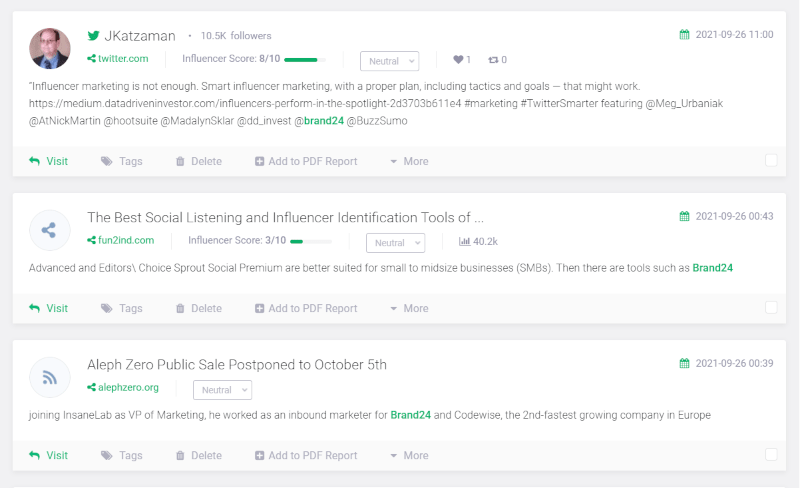
Sentiment and engagement are metrics that will help you deliver exquisite customer service to your clients.
Social channels give you a chance to talk to your clients openly.
It’s a goldmine of knowledge to spot any recurring issues your customers might encounter. Then you can solve them and turn clients into brand ambassadors. Also, you can improve your social interactions and customer satisfaction by reducing the average response time.
5. Influencers
Influencer marketing sparks a love-hate relationship among social media marketers. The surge in negative comments about influencers is caused mainly by a lack of research and basing the decisions on faulty premises.
But, influencers can affect the bottom line of your business — sales levels. Choosing the right public persona to work with is crucial for a successful social media marketing campaign.
Carefully chosen social media metrics will help you determine the right person to work with.
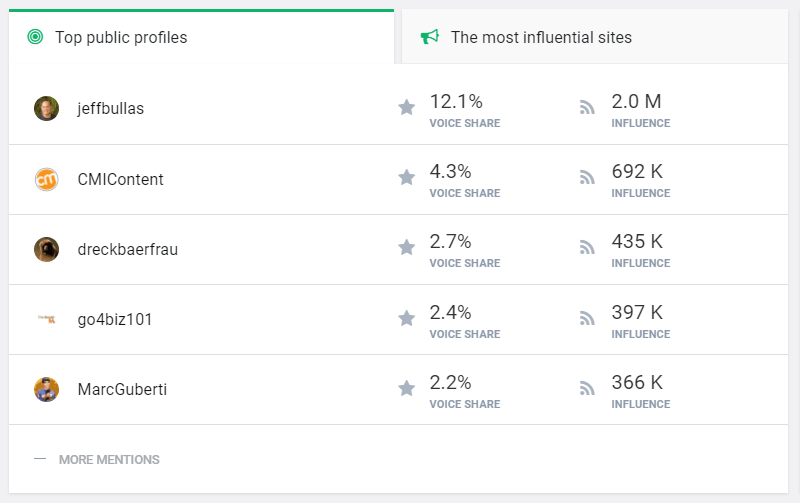
A social media monitoring tool checks the talk around your brand or your industry niche (depending on your social media monitoring project) and prepares a list of the most influential profiles already talking about your brand.
Combine the influencer score with sentiment analysis (just to make sure you’re not going to work with someone who ignites a lot of controversy and negative emotions), and you’re ready to conquer the world of influencer marketing.
The share of voice and influence are metrics used to identify brand advocates. If one of your tactics involves influencer marketing, you should examine the SOV closely. The metric can be a substitute to influence scores.
An influencer campaign is one of the most effective campaigns on social media, especially if your KPI is an engagement metric.
Influencers endorse your product or service with social credibility. An influencer will act as a digital marketing evangelist, spreading the good word about your brand.
6. The share of voice
The last metric I’d like to focus on is called the share of voice.
It indicates what percentage of the whole discussion was generated by the social media user or page.
The more people talk about your company online, the better your channels are performing. Combine this metric with social media sentiment analysis, and you will know who is talking and how they feel about your company.
The share of voice is the creme de la creme of your social media analysis.
How influential is your own profile? Are you a starting point when it comes to sparking discussion among your followers?
The share of voice metric will help determine whether you’re the industry leader or not.

Bonus Tip: Start to measure Presence Score
Now, I would like to tell you about a new feature we had implemented in Brand24 some time ago.
Are you aware of how popular your brand is on social media? No? Don’t worry.
Presence Score metric allows checking brand/topic online popularity in a given period. It helps to measure brand awareness and evaluate marketing and PR efforts.
Presence Score operates on a scale from 0 to 100, where huge, worldwide recognizable brands achieve 100.
Our tool Brand24 automatically compares your results with the popularity of other brands/topics.
We created the metric to help you understand awareness around your brand, competitors, or topics of your interest.

What metrics could you disregard?
Certainly all the vanity metrics. It might be tempting to base your social media ROI on metrics such as the number of followers or the number of likes, but that’s a dead end.
Building a robust social media presence is not about gathering the biggest audience; it’s about reaching the audience that will respond positively to your message.
Social media accounts with high followers numbers but low interactions rate are, most likely, fake accounts powered by bots. Putting your energy into building such an account is equal to broadcasting into the void.
How to track social media performance?
You know what metrics to track. But how do you do it exactly?
Marketers have many proven ways to track their marketing efforts. There are, however, some basics when it comes to social media analytics.
Google Analytics
It’s hard to imagine measuring social media performance without Google Analytics. Does it sound counterintuitive?
Well, it’s true that GA primarily gathers data about your website traffic and not about any social media platform. But GA helps you track social referral traffic to your landing pages.
This feature is especially important when you’re working on the awareness of your brand or have implemented sponsored social media post.
I’m sure that one of the most important ROI metrics is conversions, especially if you run an online shop. In that case, I advise implementing UTM tracking and measuring the results through Google Analytics.
All you have to do is to set up a Google Analytics account to track conversions, and voilà!
Every time someone signs up to your newsletter, signs up for a trial, or buys your product, you will be able to see this event in Google Analytics.
Media monitoring tool
Social media networks require constant attention. As a social media manager, you have to monitor what is being said about your brand online. Monitoring social networks will inform your strategy on the number of things:
- What social media network is the most popular among your target audience
- What type of content is the most popular among your target audience
- How your social media stack against your competitors
- How to report the results of your social media efforts to your supervisors
Brand monitoring tools make competitive analysis easy. All you have to do is, enter the keyword you’d like to monitor across the Web.
Moreover, many brand monitoring tools, including Brand24, allow you to define your reporting period and create customizable PDF reports.
You can then share the reports with your marketing team, other stakeholders, or your supervisors. You can show the effect of your work on your company’s business goals.
Try our tool for free & start social media monitoring!
Social media scheduling tool
Besides monitoring your online performance, you need a separate tool to schedule content for your channels. Many social scheduling tools, apart from the scheduling option, give you other functionalities, for example:
- Discover your audience growth rate
- Track the total number of followers
- Discover different engagement metrics, including Facebook engagement metrics
- Measure the click-through rate of your social posts
- Track social traffic
What’s more, scheduling tools, for example, Buffer, will make posting much easier, especially if your social team is posting on many different social platforms.
Depending on what you want to achieve, you can easily track the conversion rate from social media.
How to measure social media marketing metrics? Final tips:
We can track dozens of metrics. But what really matters is to follow metrics related to your goals.
If you track your data consistently, you will have a ton of actionable insights that will help improve your social media presence.
Also, tracking social media is the only way to improve and report ROI.
Information is power, and the more you know about your social media activities, the better decisions you can make.
It’s high time to start measuring how well your social media content is performing. Use the tips presented above and combine them with an analysis and monitoring tool like Brand24. Here you can try it for free:


![8 Powerful Instagram Analytics Tools [and 15 Metrics to Track]](png/instagram-analytics-tools800-640x300.png)


